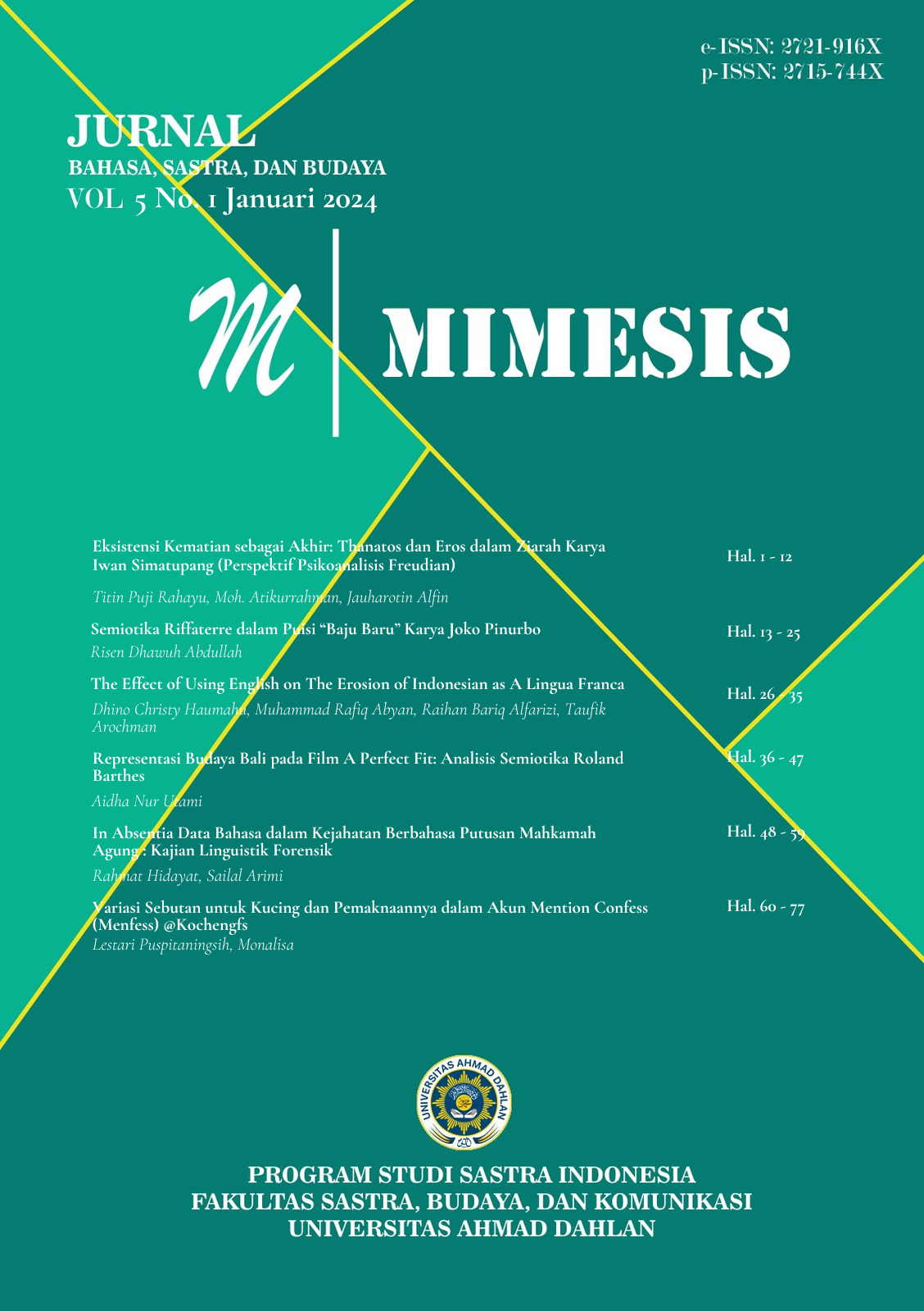Variasi Sebutan untuk Kucing dan Pemaknaannya dalam Akun Mention Confess (Menfess) @Kochengfs
DOI:
https://doi.org/10.12928/mms.v5i1.9989Keywords:
Appellation, Cat, Menfess, Semiotics, Trichotomy relationAbstract
Variations in the appellation of cat are created because cat is marked as something important for humans. One influential factor in the emergence of variations in the appellation is the existence of interaction spaces among cat lovers. One of them is menfess account @kochengfs. This research examines the various appellation for cat and their meanings in the menfess account @kochengfs. The purpose of this research is to describe the variation of appellations for cat and their meanings in the menfess account @kochengfs. This research is included in the qualitative descriptive research. This research uses a semiotic approach with the trichotomous relation theory from Peirce. The data source of this research comes from the mention confess (menfess) account @kochengfs with a corpus of research data in the form of 1,758 tweets taken from 17–24 February 2023. Based on the analysis, there are 214 tweets containing 37 appellations for cat. The appellations are dominated by icon signifying with a total of 24 appellations, then symbols with 12 appellations, and index only 1 appellation. Appellations with icon signifying are based on (a) body shape; (b) body hair; (c) voice imitation; (d) fur color; (e) teeth shape; and (f) physical characteristic.
References
Astuti, S. Y., & Kusuma, Y. (2023). Makna Representamen Kendaraan Pada Film Animasi Anak Car Toons Compilation: Kajian Semiotika C.S. Peirce Representamen’S Vehicle in Children Animated Film Car Toons Compilation: Semiotics Analysis of C.S. Peirce. Ilmu Sastra Dan Linguistik, 24, 72–85.
Bambang, M. (2013). Semiotics In Research Method of Communication. Jurnal Penelitian Komunikasi, Informatika Dan Media Massa, 16(1), 73–82. https://media.neliti.com/media/publications/222421-semiotics-in-research-method-of-communic.pdf
Danesi, M. (2011). Pesan, Tanda, dan Makna (Kedua). JALASUTRA.
Diman, P., Purwaka, A., & Maleyati, I. N. (2020). Relasi Sistem Tanda Verbal Dan Tanda Visual Pada Iklan Rokok Di Youtube. Suar Betang, 15(2), 233–243. https://doi.org/10.26499/surbet.v15i2.208
Ding, E. (2016). Rethinking the Peircean trichotomy of icon, index, and symbol. Semiotica, 2016(213), 165–175. https://doi.org/10.1515/sem-2015-0134
Hermandra, N. (2022). Analisis Semantik terhadap Nama Diri Mahasiswa. Suar Betang, 17(2), 223–231. https://doi.org/10.26499/surbet.v17i2.436
Hoed, B. H. (2014). Semiotik dan Dinamika Sosial Budaya (Ketiga). Komunitas Bambu.
Idrus, I. (2017). Relevansi Gambar Dan Tuturan Pada Komik Shin Kobochan Tinjauan Pragmatik. Puitika, 13(1), 32. https://doi.org/10.25077/puitika.13.1.32--48.2017
Koentjaraningrat. (1979). Pengantar Ilmu Antropologi. Aksara Baru.
Kusno, A. (2018). Perkembangan Fungsi Pragmatik Pada Anak Usia 2,5 Tahun (Studi Kasus Pada Azza Aqila Jihan Syuasabitha). Kadera Bahasa, 9(1), 39–52. https://doi.org/10.47541/kaba.v9i1.4
Kuzu, T. S. (2016). The Impact of a Semiotic Analysis Theory-Based Writing Activity on Students’ Writing Skills. Eurasian Journal of Educational Research, 16(63), 34–54. https://doi.org/10.14689/ejer.2016.63.3
Mahsun. (2005). Metode Penelitian Bahasa. PT Raja Grafindo Persada.
Mailani, O., Nuraeni, I., Syakila, S. A., & Lazuardi, J. (2022). Bahasa Sebagai Alat Komunikasi Dalam Kehidupan Manusia. Kampret Journal, 1(1), 1–10. https://doi.org/10.35335/kampret.v1i1.8
Pujiati, T. (2015). Analisis Semiotika Struktural pada Iklan Top Coffe. Jurnal Sasindo UNPAM, 3(3), 1–22. http://openjournal.unpam.ac.id/index.php/Sasindo/article/view/386
Pusat Bahasa. (2008). KAMUS BAHASA INDONESIA. Departemen Pendidikan Nasional.
Short, T. L. (2007). Peirce’s Theory of Signs. Cambridge University Press.
Silviana, L., Tayo, Y., & Utamidewi, W. (2021). Pola Interaksi Pengguna Twitter Pada Akun Menfess @Areajulid (Studi Etnografi Virtual Pengguna Twitter pada Akun Menfess @Areajulid). Jurnal Ilmiah Wahana Pendidikan, 7(1), 1–7. https://doi.org/10.5281/zenodo.6622323
Siregar, E. D., & Wulandari, S. (2020). Kajian Semiotika Charles Sanderspierce: Relasitrikotomi (Ikon,Indeks dan Simbol) dalam Cerpen anak Mercusuar karya Mashdar Zainal. Titian: Jurnal Ilmu Humaniora, 04(1), 29–41. https://online-journal.unja.ac.id/index.php/titian
Sobur, A. (2003). Semiotika Komunikasi. Remaja Rosdakarya.
Sudaryanto. (2015). Metode dan Aneka Teknik Analisis Bahasa. Sanata Dharma University Press.
Suhardi, N., & Salamah, N. (2022). Kajian Semiotik Puisi-Puisi Karya Sosiawan Leak. Suar Betang, 17(2), 139–150. https://doi.org/10.26499/surbet.v17i2.349
Suswandi, I. (2022). PAK ! : ANALISIS TINDAK TUTUR ILOKUSI The Content of Sexuality in The Dialog of The Comedy Show An Analysis of Illocutionary Speech Acts. Mlangun: Jurnal Ilmiah Kebahasaan & Kesastraan, 19(2), 107–125. https://jurnalmlangun.kemdikbud.go.id/ojs2022/index.php/mlangun/article/view/17
Thornbury, C. (2011). Peirce ’ s General Theory of Signs. Finding Meaning, Cultures Across Borders: International Dialogue between Philosophy and Psychology, 49–57. http://hdl.handle.net/2433/143046
Werdiningsih, Y. K., & Umaya, N. M. (2017). Variasi Nama Tuhan Dalam Teks Serat Sastra Gendhing, Kajian Akulturasi Terhadap Sastra Suluk. El-HARAKAH (TERAKREDITASI), 19(1), 79. https://doi.org/10.18860/el.v19i1.3827
Widyastuti, S. H. (2022). Semiotic analysis in Islamic-Javanese healing texts. Indonesian Journal of Applied Linguistics, 11(3), 684–696. https://doi.org/10.17509/ijal.v11i3.43708
Wulandari, A. (2016). PENGGUNAAN JARGON OLEH KOMUNITAS CHATTING WHATSAPP GRUP. Transformatika, 12(2), 579–587. https://jurnal.untidar.ac.id/index.php/transformatika/article/view/190
Downloads
Published
Issue
Section
License
Copyright (c) 2024 Lestari Puspitaningsih, Monalisa

This work is licensed under a Creative Commons Attribution-ShareAlike 4.0 International License.
License and Copyright Agreement
In submitting the manuscript to the journal, the authors certify that:
- They are authorized by their co-authors to enter into these arrangements.
- The work described has not been formally published before, except in the form of an abstract or as part of a published lecture, review, thesis, or overlay journal.
- That it is not under consideration for publication elsewhere,
- That its publication has been approved by all the author(s) and by the responsible authorities tacitly or explicitly of the institutes where the work has been carried out.
- They secure the right to reproduce any material that has already been published or copyrighted elsewhere.
- They agree to the following license and copyright agreement.
Copyright
Authors who publish with Mimesis agree to the following terms:
- Authors retain copyright and grant the journal right of first publication with the work simultaneously licensed under a Creative Commons Attribution License (CC BY-SA 4.0) that allows others to share the work with an acknowledgment of the work's authorship and initial publication in this journal.
- Authors are able to enter into separate, additional contractual arrangements for the non-exclusive distribution of the journal's published version of the work (e.g., post it to an institutional repository or publish it in a book), with an acknowledgment of its initial publication in this journal.
- Authors are permitted and encouraged to post their work online (e.g., in institutional repositories or on their website) prior to and during the submission process, as it can lead to productive exchanges, as well as earlier and greater citation of published work.











